
Verdon Gorge: The Grand Canyon of Europe
Explore Verdon Gorge, France's breathtaking natural canyon with turquoise waters, towering cliffs, and endless outdoor adventure opportunities in the heart of Provence.
Verdon Gorge, often called the Grand Canyon of Europe, is a natural wonder located in the Provence-Alpes-Côte d'Azur region of southeastern France. This stunning river canyon is carved by the Verdon River and stretches for about 25 kilometers, with cliffs that can reach up to 700 meters in height. The gorge is renowned for its turquoise-blue waters, which provide a striking contrast to the limestone cliffs that surround it. The area is a paradise for outdoor enthusiasts. You can hike along numerous trails that offer breathtaking views of the gorge, or take a leisurely paddle in a kayak to explore the river below. For the more adventurous, rock climbing and paragliding offer thrilling ways to experience the stunning scenery from different angles. The Verdon Gorge also boasts several scenic drives, including the famous Route des Crêtes, which offers panoramic views that are perfect for photo opportunities. Wildlife is abundant in the region, making it a great spot for nature lovers. You may encounter golden eagles, griffon vultures, and a variety of other bird species. The flora is equally diverse, with lavender fields, oak forests, and rare plant species adding to the area's natural beauty. Nearby villages like Moustiers-Sainte-Marie offer charming spots to rest, dine, and immerse yourself in local culture, completing the experience of visiting this spectacular destination.
Local tips in Verdon Gorge
- Visit in late spring or early fall to avoid the summer crowds and enjoy milder weather.
- Wear sturdy hiking shoes if you plan to explore the trails; the terrain can be rugged.
- Bring a picnic; there are many scenic spots to enjoy a meal with a view.
- Check local weather conditions before heading out; sudden changes can occur.
- Rent a kayak in advance during peak season to ensure availability.
Verdon Gorge: The Grand Canyon of Europe
Verdon Gorge, often called the Grand Canyon of Europe, is a natural wonder located in the Provence-Alpes-Côte d'Azur region of southeastern France. This stunning river canyon is carved by the Verdon River and stretches for about 25 kilometers, with cliffs that can reach up to 700 meters in height. The gorge is renowned for its turquoise-blue waters, which provide a striking contrast to the limestone cliffs that surround it. The area is a paradise for outdoor enthusiasts. You can hike along numerous trails that offer breathtaking views of the gorge, or take a leisurely paddle in a kayak to explore the river below. For the more adventurous, rock climbing and paragliding offer thrilling ways to experience the stunning scenery from different angles. The Verdon Gorge also boasts several scenic drives, including the famous Route des Crêtes, which offers panoramic views that are perfect for photo opportunities. Wildlife is abundant in the region, making it a great spot for nature lovers. You may encounter golden eagles, griffon vultures, and a variety of other bird species. The flora is equally diverse, with lavender fields, oak forests, and rare plant species adding to the area's natural beauty. Nearby villages like Moustiers-Sainte-Marie offer charming spots to rest, dine, and immerse yourself in local culture, completing the experience of visiting this spectacular destination.
When is the best time to go to Verdon Gorge?
Iconic landmarks you can’t miss
Verdon Natural Regional Park
Explore the natural wonders of Verdon Natural Regional Park, where adventure meets breathtaking beauty in the heart of Provence.

Pont du Galetas
Discover the breathtaking beauty of Pont du Galetas, an iconic bridge offering stunning views and a serene escape in Southern France's Verdon Gorge.

Point Sublime
Experience the breathtaking vistas of Point Sublime, an iconic observation deck in Rougon, showcasing the stunning Gorges du Verdon.

Gorges Du Verdon
Explore the breathtaking Gorges du Verdon, a natural wonder in France, featuring stunning cliffs, turquoise waters, and endless outdoor adventures.

Balcon de la Mescla
Discover the stunning vistas of Balcon de la Mescla, a premier observation deck in Provence offering unforgettable views of Verdon Gorge's captivating landscapes.

Corniche sublime
Explore the Corniche Sublime, where breathtaking views of the Verdon Gorge await in the heart of Provence, France.

verdon gorge france
Explore the breathtaking Verdon Gorge, a majestic natural wonder in France, offering stunning views, outdoor adventures, and charming Provençal villages.

Unmissable attractions to see
Verdon Natural Regional Park
Explore the stunning landscapes and diverse wildlife of Verdon Natural Regional Park, a true haven for nature lovers and adventure seekers in Provence.
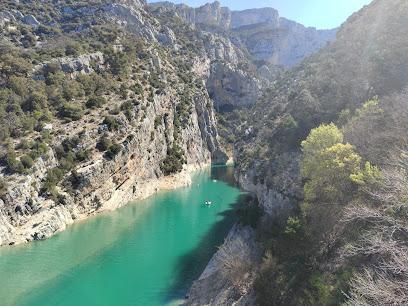
Roc D'Azur
Discover the natural beauty and recreational offerings of Roc D'Azur in Fréjus, a perfect destination for outdoor enthusiasts and families.

Pont du Galetas
Experience breathtaking views at Pont du Galetas, the scenic bridge in Aiguines, overlooking the stunning Verdon Gorge in Provence, France.

Gorges Du Verdon
Explore the Gorges Du Verdon, a majestic natural wonder featuring stunning turquoise waters and dramatic cliffs in southeastern France.

Belvédère de la Carelle
Discover the breathtaking views of Verdon Gorge from Belvédère de la Carelle, a must-visit observation deck in La Palud-sur-Verdon, France.

Le Roc au Serre et la chapelle Notre-Dame du Roc
Explore the breathtaking Roc au Serre and Notre-Dame du Roc Chapel, a blend of stunning natural beauty and rich cultural heritage in Castellane, France.

Point de Départ du Sentier Blanc-Martel
Explore the stunning trails of Point de Départ du Sentier Blanc-Martel, where breathtaking views and nature await every hiker.

Adventure Forest
Experience the thrill of Adventure Forest in Castellane, where breathtaking views meet exhilarating outdoor activities for the whole family.

Tunnel du Baou
Discover the enchanting Tunnel du Baou in La Palud-sur-Verdon, a natural marvel inviting exploration and appreciation of its stunning geological beauty.

Grotte des Gorges du Verdon
Discover the breathtaking Grotte des Gorges du Verdon, a stunning natural attraction in Montagnac-Montpezat, offering adventure and mesmerizing underground beauty.

Balcon de la Mescla
Explore the breathtaking views of Verdon Gorge from Balcon de la Mescla, a must-visit observation deck in the heart of Provence.

Pont du Roc
Experience the breathtaking views and historical charm of the Pont du Roc in Castellane, a bridge that connects nature and culture.
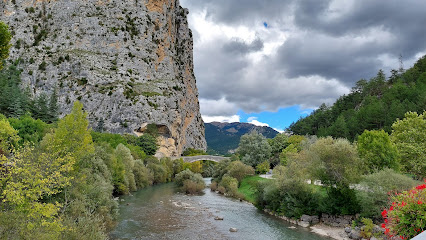
Cascade du Riou
Discover the enchanting Cascade du Riou, a stunning waterfall in Moustiers-Sainte-Marie that offers breathtaking views and a peaceful retreat into nature.

Les Sireniens
Explore the ancient world at Les Sireniens, a fossil site in Castellane showcasing remarkable marine mammal remains amidst stunning Alpine scenery.

Cascade Saint Maurin
Discover the natural beauty and thrilling aquatic adventures at Cascade Saint Maurin in La Palud-sur-Verdon, a must-visit tourist attraction.
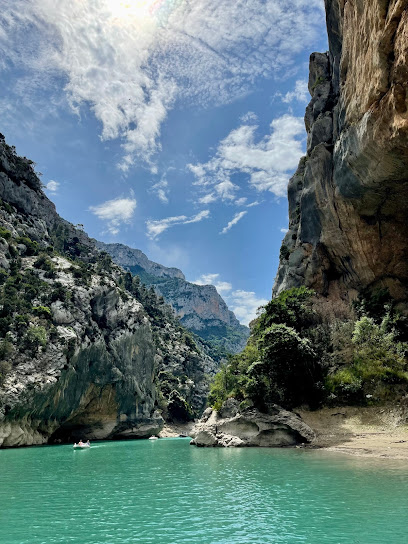
Essential places to dine
Crêperie Le Mur d'Abeilles
Discover authentic French crêpes in Rougon's charming Crêperie Le Mur d'Abeilles, where every bite tells a story.
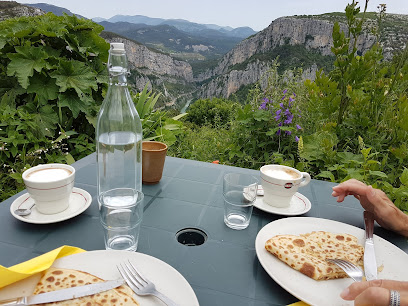
Restaurant Le Côté Lac
Experience exquisite French and Mediterranean cuisine at Restaurant Le Côté Lac with breathtaking lakeside views.

Joe Le Snacky
Experience the flavors of La Palud-sur-Verdon at Joe Le Snacky – a charming restaurant renowned for its savory meals and delightful sundaes.

La Cascade
Discover authentic French cuisine at La Cascade in Moustiers-Sainte-Marie - where culinary tradition meets breathtaking scenery.

Restaurant Les Tables Du Cloitre
Discover exquisite French and Mediterranean cuisine at Restaurant Les Tables Du Cloitre in the heart of Moustiers-Sainte-Marie.

Château de Trigance
Experience the historical charm and natural beauty of Château de Trigance – a hidden gem in Provence perfect for adventure seekers and relaxation lovers.

Le Relais des Balcons
Experience authentic fast food and local culture at Le Relais des Balcons in Rougon, where culinary delights meet breathtaking scenery.
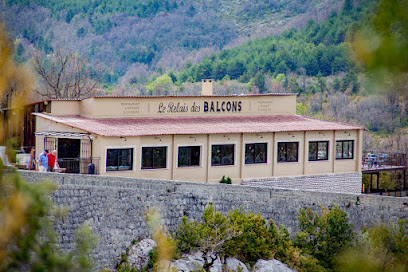
Le vieux château
Experience the best of French cuisine and hospitality at Le Vieux Château in Aiguines – where every meal is a celebration.

Ma Petite Auberge
Discover the charm of Castellane at Ma Petite Auberge - where cozy accommodations meet exquisite French dining.

Auberge du Point Sublime Gorges du Verdon
Discover unparalleled beauty and exquisite French cuisine at Auberge du Point Sublime in Gorges du Verdon.

Auberge des Crêtes 930m
Discover the essence of Provence at Auberge des Crêtes: a charming hotel with authentic French cuisine amidst breathtaking natural beauty.

Hôtel & Spa des Gorges du Verdon
Experience luxury amidst nature at Hôtel & Spa des Gorges du Verdon – your perfect escape with exquisite dining and rejuvenating spa treatments.

Le Rhumarin
Discover exquisite French cuisine at Le Rhumarin in beautiful Sainte-Croix-du-Verdon, where every meal is a celebration of local flavors.

Ferme Sainte-Cécile
Experience authentic regional cuisine at Ferme Sainte-Cécile amidst stunning natural landscapes in Parc naturel régional du Verdon.

Auberge du castellas
Experience authentic Provençal cuisine at Auberge du Castellas amidst breathtaking views in Sainte-Croix-du-Verdon.

Markets, malls and hidden boutiques
Crêperie Le Mur d'Abeilles
Experience the authentic taste of France at Crêperie Le Mur d'Abeilles in Rougon, famous for its delightful crêpes and stunning views.

La Terrasse de Rougon
Discover the culinary treasures of Rougon at La Terrasse de Rougon, where stunning views meet exquisite French cuisine.

L'Épice Rit Aiguines
Discover the authentic flavors of Provence at L'Épice Rit Aiguines, your go-to grocery store for local delicacies and culinary treasures.

Maison de Produits de Pays des Gorges du Verdon
Experience the authentic taste of Provence at Maison de Produits de Pays des Gorges du Verdon, where local flavors meet culinary tradition.

Culture CBD France
Discover wellness at Culture CBD France, a top destination for dried flowers, organic products, and aromatherapy in the heart of Castellane.

Supérette Proxi
Explore La Palud-sur-Verdon with ease at Supérette Proxi, your one-stop convenience store for all your travel essentials.

L'épicerie du coin
Explore the exquisite flavors of Provence at L'épicerie du coin, your go-to gourmet grocery store and wine cellar in Moustiers-Sainte-Marie.

Folies de Provence
Explore Folies de Provence in Moustiers-Sainte-Marie, where artisan cosmetics meet gourmet delicacies, creating a unique shopping experience.

Le Panier Du Verdon
Explore the culinary delights of Le Panier Du Verdon, a gourmet grocery store offering local delicacies and artisanal products in La Palud-sur-Verdon.

Le Fil D'Ariane
Explore Le Fil D'Ariane in Castellane for an exquisite selection of clothing and shoes that embodies the essence of French fashion and local craftsmanship.

Au Tresor De Provence
Explore the essence of Provence at Au Trésor de Provence, where local flavors and unique crafts await every discerning traveler.

Autour de la Table
Discover the flavors of Aiguines at Autour de la Table, where gourmet delights and local specialties await every food lover.

Au Coeur du Moulin
Explore Au Coeur du Moulin in Moustiers-Sainte-Marie for an exquisite selection of artisanal gift baskets, showcasing local flavors and craftsmanship.

La Chaîne
Explore La Chaîne in Moustiers-Sainte-Marie for unique gifts and local artisan crafts that capture the essence of the region's rich culture.

Le Pavillon
Explore the essence of Castellane at Le Pavillon, where local crafts, gourmet delights, and the charm of Provence await you.

Essential bars & hidden hideouts
Crêperie Le Mur d'Abeilles
Discover the authentic taste of France with delicious crêpes and stunning views at Crêperie Le Mur d'Abeilles in Rougon.

Moulin de Soleils
Experience the best of French cuisine and artisanal pizzas at Moulin de Soleils, where breathtaking views meet delightful flavors in Verdon.

Le Relais des Balcons
Discover Le Relais des Balcons in Rougon, a charming bar and fast food restaurant with stunning views and local souvenirs, perfect for tourists.

Brasserie du petit lac
Discover the culinary delights of Brasserie du Petit Lac in Moustiers-Sainte-Marie, where local flavors meet stunning views in a charming atmosphere.

La Guinguette du Lac
Discover the delightful flavors of La Guinguette du Lac, a charming restaurant in Aiguines specializing in exquisite pizzas with stunning lakeside views.

Lou Cafetié - Restaurant feu de bois, Bar, Live Music
Discover Lou Cafetié: A wood-fired culinary experience with live music in the heart of La Palud-sur-Verdon.

Le vieux château
Discover the charm of Le Vieux Château in Aiguines, where delightful cuisine meets breathtaking views in the heart of Provence.

Idéal Bar
Discover Idéal Bar in Castellane for a delightful mix of craft beers, tapas, and a vibrant atmosphere in the heart of the French countryside.

Auberge du Point Sublime Gorges du Verdon
Discover the exquisite fusion of French cuisine and breathtaking scenery at Auberge du Point Sublime, your gateway to Gorges du Verdon.

Bar restaurant De la Place
Savor the flavors of France at Bar Restaurant De la Place, a charming eatery in La Palud-sur-Verdon, where local cuisine meets stunning views.
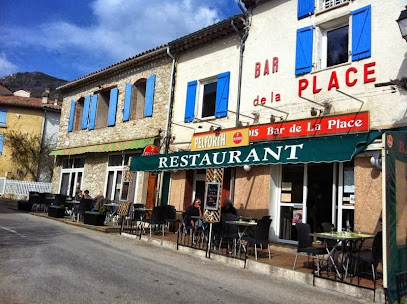
Le Rive Gauche
Experience the essence of French cuisine at Le Rive Gauche in Aiguines, where local flavors meet a charming ambiance.

La Terrasse de Rougon
Experience the best of Rougon at La Terrasse de Rougon, where delicious cuisine meets stunning views in a charming atmosphere.

Snack Bar Le Piccolo
Experience the charm of Trigance at Snack Bar Le Piccolo, where delightful snacks and local drinks await in a cozy setting.

Sirocco
Discover Sirocco, a cozy bar in Castellane offering refreshing drinks and stunning views, perfect for unwinding after your adventures.
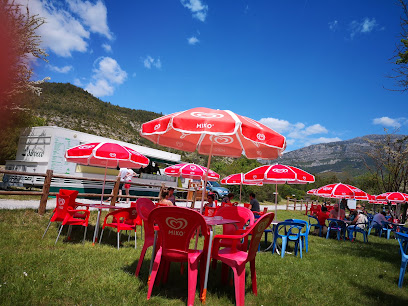
Auberge Des Cavaliers
Experience traditional Provençal cuisine with stunning views at Auberge Des Cavaliers, a culinary oasis overlooking the breathtaking Verdon Canyon.

Local Phrases about Verdon Gorge
-
- HelloBonjour
[bon-zhoor] - GoodbyeAu revoir
[oh ruh-vwahr] - YesOui
[wee] - NoNon
[noh] - Please/You're welcomeS'il vous plaît / De rien
[seel voo pleh / duh ryen] - Thank youMerci
[mehr-see] - Excuse me/SorryExcusez-moi / Désolé
[ex-kew-zay mwah / day-zoh-lay] - How are you?Comment ça va?
[koh-mohn sah vah?] - Fine. And you?Bien. Et vous?
[byen. ay voo?] - Do you speak English?Parlez-vous anglais?
[par-lay voo ahn-glay?] - I don't understandJe ne comprends pas
[zhuh nuh kohm-prahnd pah]
- HelloBonjour
-
- I'd like to see the menu, pleaseJe voudrais voir la carte, s'il vous plaît
[zhuh voo-dray vwahr lah kart, seel voo pleh] - I don't eat meatJe ne mange pas de viande
[zhuh nuh mahnj pah duh vyand] - Cheers!Santé!
[sahn-tay] - I would like to pay, pleaseJe voudrais payer, s'il vous plaît
[zhuh voo-dray pay-yay, seel voo pleh]
- I'd like to see the menu, pleaseJe voudrais voir la carte, s'il vous plaît
-
- Help!Au secours!
[oh seh-koor] - Go away!Allez-vous en!
[ah-lay voo zahn] - Call the Police!Appelez la police!
[ah-pay-lay lah police] - Call a doctor!Appelez un médecin!
[ah-pay-lay uh may-suh-dan] - I'm lostJe suis perdu
[zhuh swee pair-doo] - I'm illJe suis malade
[zhuh swee mah-lahd]
- Help!Au secours!
-
- I'd like to buy...Je voudrais acheter...
[zhuh voo-dray zah-shtay...] - I'm just lookingJe regarde juste
[zhuh ruh-gard zhust] - How much is it?Combien ça coûte?
[kohm-byen sah koot?] - That's too expensiveC'est trop cher
[say troh shair] - Can you lower the price?Pouvez-vous baisser le prix?
[poo-veh voo beh-say luh pree?]
- I'd like to buy...Je voudrais acheter...
-
- What time is it?Quelle heure est-il?
[kel uh-ruh ay eel?] - It's one o'clockIl est une heure
[eel ay oon uh-ruh] - Half past (10)Dix heures et demie
[dees uh-ruh ay duh-mee] - MorningMatin
[mah-tahn] - AfternoonAprès-midi
[ah-pray mee-dee] - EveningSoir
[swahr] - YesterdayHier
[yeer] - TodayAujourd'hui
[oh-zhoor-dwee] - TomorrowDemain
[duh-mahn] - 1Un
[uhn] - 2Deux
[duh] - 3Trois
[twah] - 4Quatre
[kah-truh] - 5Cinq
[sank] - 6Six
[sees] - 7Sept
[sept] - 8Huit
[weet] - 9Neuf
[nuhf] - 10Dix
[dees]
- What time is it?Quelle heure est-il?
-
- Where's a/the...?Où est le/la...?
[oo ay luh/la] - What's the address?Quelle est l'adresse?
[kel ay lad-res] - Can you show me (on the map)?Pouvez-vous me montrer (sur la carte)?
[poo-veh voo muh mon-tray (sir lah kart)] - When's the next (bus)?Quand est le prochain (bus)?
[kahnd ay luh proh-shay (bus)] - A ticket (to ....)Un billet (pour ...)
[uhn bee-yay (poor ...)]
- Where's a/the...?Où est le/la...?
History of Verdon Gorge
-
Verdon Gorge, also known as the 'Grand Canyon of Europe,' was formed over millions of years through the erosion caused by the Verdon River. The limestone cliffs, which rise to heights of 700 meters, were created during the Jurassic period, about 150 million years ago. The river gradually carved its way through the rock, creating the stunning canyon we see today.
-
The area around Verdon Gorge has been inhabited since prehistoric times, as evidenced by numerous archaeological finds. Paleolithic and Neolithic tools, as well as cave paintings, have been discovered in the region, indicating that early humans found shelter and resources in the gorge.
-
During the Roman era, the Verdon Gorge region was part of the province of Gallia Narbonensis. The Romans constructed roads and bridges to facilitate travel and trade across the rugged landscape. Remnants of these ancient infrastructures can still be found today, showcasing the engineering prowess of the Roman Empire.
-
In the Middle Ages, the Verdon Gorge area was dotted with small villages and fortresses. The rugged terrain provided natural defense against invasions and conflicts. One notable site from this period is the village of Rougon, which offers a glimpse into medieval life in the region.
-
In the 20th century, the Verdon Gorge gained recognition as a natural wonder and became a popular destination for tourists and adventurers. The construction of the Sainte-Croix Dam in the 1970s created the beautiful Lac de Sainte-Croix, which further enhanced the area's appeal. Today, Verdon Gorge is a protected natural reserve, attracting visitors from around the world.
Verdon Gorge Essentials
-
The Verdon Gorge is located in the Provence-Alpes-Côte d'Azur region of southeastern France. The nearest international airports are Nice Côte d'Azur Airport, which is approximately 115 kilometers to the east, and Marseille Provence Airport, around 145 kilometers to the southwest. From these airports, you can rent a car or take a train to Les Arcs-Draguignan or Manosque-Gréoux-les-Bains, the nearest train stations. From these stations, you can rent a car or take a local bus to get to the Verdon Gorge.
-
The best way to explore Verdon Gorge is by car, as it provides the flexibility to visit various viewpoints and hiking trails. Car rentals are available at the nearest airports and train stations. Public transportation options are limited, but local buses do connect some of the nearby towns and villages. Additionally, guided tours are available and can be a convenient way to experience the highlights of the region without worrying about navigation.
-
The official currency in France is the Euro (EUR). Credit and debit cards are widely accepted in most hotels, restaurants, and shops in the Verdon Gorge area. However, it is advisable to carry some cash, especially when visiting smaller villages or rural areas where card payment options might be limited. ATMs are available in larger towns such as Castellane and Moustiers-Sainte-Marie.
-
The Verdon Gorge is generally a safe destination for tourists. However, standard precautions should still be taken. Avoid leaving valuables in your car when parked at viewpoints or hiking trailheads. There are no specific high-crime areas targeting tourists, but it's always best to stay vigilant and aware of your surroundings. When hiking, ensure you are well-prepared with maps, sufficient water, and appropriate footwear.
-
In case of emergency, dial 112, the European emergency number, which will connect you to local services such as police, fire department, and medical assistance. The nearest hospitals are located in Digne-les-Bains and Draguignan. It's advisable to have travel insurance that covers medical emergencies. For minor health issues, pharmacies can be found in the larger towns around the gorge.
-
Fashion: Do wear comfortable and practical clothing suitable for outdoor activities. Avoid wearing flip-flops or other unsuitable footwear when hiking. Religion: Do respect local religious customs if visiting churches or religious sites. Public Transport: Do be polite and patient when using local buses. Don't expect frequent services, especially in rural areas. Greetings: Do greet people with a friendly 'Bonjour' and a smile. A handshake is common among acquaintances. Eating & Drinking: Do try the local cuisine, including regional specialties such as lavender honey and Provençal dishes. Don't forget to sample the local wines, but always drink responsibly.
-
To experience Verdon Gorge like a local, consider visiting outside the peak tourist season in July and August. This allows you to enjoy the natural beauty without the crowds. Explore the smaller, charming villages such as Aiguines and La Palud-sur-Verdon. For a unique experience, rent a kayak or paddleboard to explore the gorge from the water. Engage with local guides to learn about the region's history, geology, and flora and fauna. Lastly, don't miss the local markets where you can buy fresh produce and artisanal products.
Nearby Cities to Verdon Gorge
-
Things To Do in Saint-Tropez
-
Things To Do in Nice
-
Things To Do in Aix-en-Provence
-
Things To Do in Les Moneghetti
-
Things To Do in Moneghetti
-
Things To Do in Fontvieille
-
Things To Do in La Condamine
-
Things To Do in Monaco-Ville
-
Things To Do in Monte Carlo
-
Things To Do in Larvotto
-
Things To Do in Saint Roman
-
Things To Do in La Rousse
-
Things To Do in Marseille
-
Things To Do in Avignon
-
Things To Do in Nîmes











